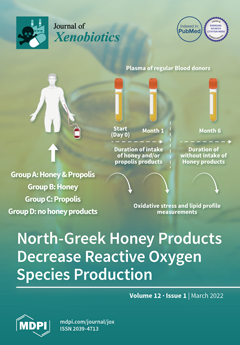Background and objectives: Honey products contain a lot of compounds, such as vitamins, enzymes, and minerals, which make honey and its products a great antioxidant with a critical role in health status. It is well accepted that honey and propolis can improve a
[...] Read more.
Background and objectives: Honey products contain a lot of compounds, such as vitamins, enzymes, and minerals, which make honey and its products a great antioxidant with a critical role in health status. It is well accepted that honey and propolis can improve a lot of health problems when they are consumed in certain quantities. The objective of this study is to help regular blood donors improve their health status after donation.
Material and methods: Eighty regular blood donor volunteers—30 males aged 19–61 and 30 females aged 21–64—were divided into 4 groups: group A (
n = 20) consumed 2 spoons of Greek honey and 1 drop of propolis per day for 1 month, group B (
n = 20) consumed 2 spoons of honey per day for 1 month, group C (
n = 20) consumed 1 drop of propolis per day, and group D (
n = 20) did not consume any Greek honey products. Blood samples were collected from all participants just before the consumption of the products, one month after the consumption, and six months after honey product consumption had ceased. All samples were analyzed for reactive oxygen species (ROS), lipid profiles, and ferritin levels.
Results: The ROS were significantly (
p < 0.05) lower in groups A, B, and C after the honey product consumption and increased significantly again after six months. No significant differences in lipid profiles were observed. Only triglyceride levels were increased after six months in all groups. On the other hand, ferritin levels were not statistically significantly decreased after six months in groups A and B, while they were increased in group C.
Conclusions: In the present study, statistically significant decreases in ROS status was found after a small dose of honey product consumption, indicating a diet with an extra small dose of honey products after blood donation.
Full article






